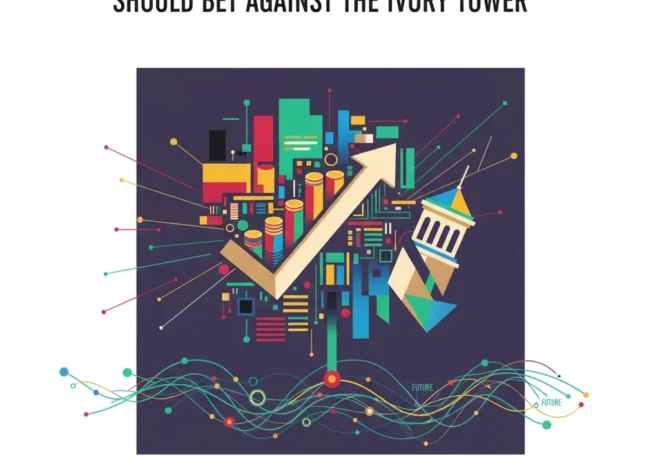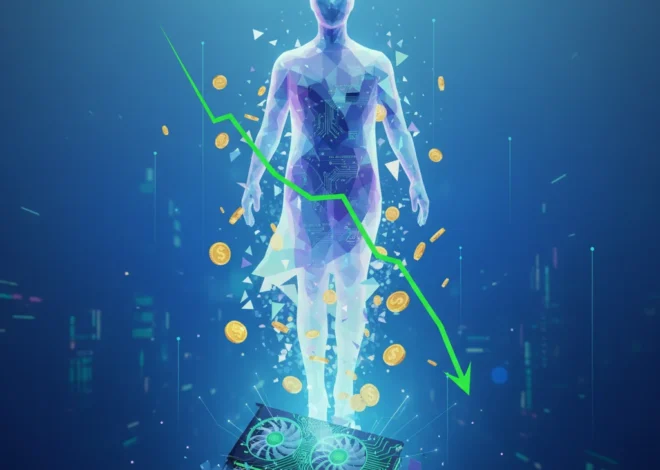
The Investor’s Crossword: Why a Polymath Mindset is Your Greatest Asset in Modern Finance
Every week, thousands of discerning readers turn to the Financial Times, not just for market-moving news, but for a different kind of challenge: the crossword. Puzzles like the Polymath crossword are more than a simple pastime; they are a masterclass in lateral thinking, pattern recognition, and the synthesis of disparate information. To solve one, you can’t just be an expert in a single domain. You must draw upon knowledge of history, science, art, and, of course, finance. You must be a polymath.
In today’s complex and interconnected global economy, the skills of a crossword solver are uncannily similar to those required of a successful investor, finance professional, or business leader. The era of siloed expertise is fading. A deep understanding of the stock market is no longer sufficient without a concurrent grasp of the disruptive power of financial technology. A mastery of traditional banking principles is incomplete without appreciating the macroeconomic forces shaping the global economy.
This article uses the framework of a crossword puzzle to explore the essential, interconnected domains of modern finance. By “solving the clues,” we will piece together a holistic view of the landscape, demonstrating why a polymath’s approach—one that embraces complexity and connects diverse fields of knowledge—is no longer a luxury, but a necessity for navigating the future of investing and finance.
Across the Board: Deciphering the Technological Revolution
The “across” clues in our financial crossword represent the horizontal forces reshaping entire industries. These are the technological undercurrents that cut across traditional boundaries, forcing every player in the economy to adapt. Two of the most significant clues in this section are fintech and blockchain.
Clue: A digital ledger transforming banking and trading. (10)
Answer: BLOCKCHAIN
Once relegated to the niche corners of the internet, blockchain has emerged as a foundational technology with the potential to rewire the core infrastructure of finance. At its heart, blockchain is a decentralized, immutable ledger. This simple concept has profound implications for everything from cross-border payments to stock market trading.
In traditional banking, transactions require a central intermediary—a bank or clearinghouse—to verify and record them. This process can be slow, expensive, and vulnerable to single points of failure. Blockchain eliminates the need for this central authority. By distributing the ledger across a network of computers, it creates a “trustless” system where transactions can be verified and settled securely and transparently. According to a 2021 survey by Deloitte, nearly 76% of finance executives believe that digital assets will be a strong alternative to, or outright replacement for, fiat currencies in the next 5–10 years, a belief heavily reliant on the maturation of blockchain technology.
The implications for investing and trading are immense. Tokenization, the process of representing real-world assets like real estate or art on a blockchain, could democratize access to previously illiquid markets. Settlement times for securities trades, which currently take two business days (T+2) in many markets, could be reduced to mere seconds, freeing up vast amounts of capital and reducing counterparty risk. While regulatory hurdles and scalability challenges remain, ignoring the transformative power of blockchain is akin to leaving a crucial 10-letter answer blank on your puzzle.
The Investor's Cryptic Crossword: Decoding the Complexities of the Modern Economy
Clue: The disruptive force merging finance and software. (7)
Answer: FINTECH
If blockchain is the deep infrastructure, financial technology (fintech) is the user-facing application layer that is revolutionizing how consumers and businesses interact with money. Fintech is not a single product but a broad ecosystem encompassing everything from mobile payment apps and robo-advisors to peer-to-peer lending platforms and AI-driven trading algorithms. Its primary goal is to make financial services more accessible, efficient, and user-friendly than those offered by traditional institutions.
The global fintech market is experiencing explosive growth, with projections suggesting it could reach a market size of nearly $700 billion by 2028. This growth is fueled by a fundamental shift in consumer expectations. Today’s customers demand seamless, digital-first experiences, and fintech startups have been quick to meet that demand, often unbundling the services of large banks and excelling at one specific thing, be it international remittances, stock trading, or personal budgeting.
For investors and business leaders, the rise of fintech presents both a threat and an opportunity. Traditional banking institutions must innovate or risk becoming obsolete, leading to a surge in partnerships and acquisitions. For the average investor, fintech has democratized access to the stock market through commission-free trading apps and sophisticated investment tools that were once the exclusive domain of high-net-worth individuals. Understanding the trajectory of fintech is critical to understanding the future of capital allocation, personal finance, and the competitive dynamics within the financial services industry.
Down the Column: Reading the Economic Fundamentals
While technology provides the horizontal axis of our puzzle, the “down” clues represent the foundational, vertical pillars that have always supported the world of finance: economics, market behavior, and the institutions that govern them. A polymath understands that technology doesn’t operate in a vacuum; it is subject to the timeless principles of human behavior and economic cycles.
Clue: The study of scarcity and resource allocation. (9)
Answer: ECONOMICS
Economics is the bedrock upon which all financial analysis is built. It is the grand narrative that provides context for every movement in the stock market, every central banking decision, and every corporate earnings report. Understanding key macroeconomic indicators—such as GDP growth, inflation rates, employment data, and consumer sentiment—is non-negotiable for any serious investor. These data points are the vital signs of the economy’s health.
For example, a rising inflation rate might prompt a central bank to increase interest rates. This, in turn, makes borrowing more expensive for companies, potentially squeezing profit margins and leading to lower stock valuations. Conversely, strong employment data can signal a robust economy, boosting consumer spending and corporate revenues. These relationships are complex and often non-linear, but grasping them is essential for making informed investment decisions rather than simply reacting to market noise.
Indonesia at a Crossroads: Prabowo, the Suharto Legacy, and the High-Stakes Game for Investors
Clue: A measure of the stock market’s mood swings. (10)
Answer: VOLATILITY
If economics provides the script, volatility is the drama. Often misunderstood as simply a measure of risk, volatility is a critical component of market dynamics. The CBOE Volatility Index (VIX), often called the “fear index,” measures the market’s expectation of 30-day volatility. A high VIX reading typically signals investor fear and uncertainty, often coinciding with stock market downturns. A low VIX suggests complacency and stability.
A polymath investor doesn’t just fear volatility; they understand it. They recognize that periods of high volatility can present buying opportunities, as sound companies are sold off indiscriminately amidst panic. They also use tools and strategies, such as diversification and options trading, to hedge against volatility’s downside. Understanding the psychology behind market swings—the interplay of greed and fear that has defined markets for centuries—is just as important as reading a financial statement. This is where knowledge of behavioral economics becomes a powerful asset, helping to explain why markets can remain irrational longer than an investor can remain solvent.
To put the interplay of traditional and modern finance in perspective, consider how they approach common financial activities:
| Financial Activity | Traditional Finance Approach | Fintech & Blockchain Approach |
|---|---|---|
| International Payments | SWIFT network, 3-5 business days, high fees. | Blockchain-based remittances, near-instant settlement, low fees. |
| Stock Trading | Broker-dealers, T+2 settlement, potential commissions. | Commission-free apps, fractional shares, potential for real-time settlement via tokenization. |
| Lending & Credit | Based on credit scores, bank underwriting, lengthy process. | AI-driven credit models using alternative data, P2P lending platforms, DeFi collateralized loans. |
| Asset Management | Human portfolio managers, high minimum investments. | Robo-advisors with algorithm-based allocation, low fees, low minimums. |
Completing the Puzzle: The Power of Synthesis
A crossword is not solved by answering a single clue. Its magic lies in the moment one answer reveals a letter that helps solve another. The ‘B’ in BLOCKCHAIN might be the first letter of BANKING. The ‘T’ in FINTECH might be the last letter in an economic concept like ‘DEBT’.
This is the essence of the polymath approach to finance. The concepts are not isolated; they are deeply interwoven. The rate of fintech adoption (a technology trend) is directly influenced by the prevailing interest rate environment (an economic factor). The potential for blockchain to disrupt the stock market (a financial structure) depends heavily on the evolving regulatory landscape (a political and legal factor).
The successful leader or investor of the 21st century must constantly be filling in their own mental crossword. They must ask questions that bridge disciplines:
- How will advancements in AI (technology) affect employment numbers (economics) and, in turn, consumer spending and corporate profits (investing)?
- How might decentralized autonomous organizations, or DAOs (blockchain), change the nature of corporate governance (finance)?
- What are the geopolitical risks (politics) that could disrupt global supply chains and trigger market volatility (trading)?
The Investor's Polymath: Decoding the Puzzles of Modern Finance
By actively seeking out these connections, you move beyond simple information gathering and into the realm of true insight. You begin to see the second- and third-order effects of events, giving you an edge in a market that too often focuses only on the immediate headline.
In conclusion, the challenge posed by a puzzle like the FT Polymath is a potent metaphor for the modern financial world. It rewards not the specialist who knows everything about one thing, but the generalist who can connect the dots between many things. Building your knowledge base across technology, economics, finance, and even psychology is the ultimate strategy for navigating uncertainty. It’s about seeing the whole board, understanding how every clue intersects, and finally, having that satisfying moment when the entire, complex picture comes into focus.


